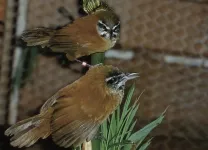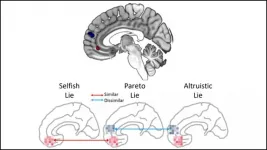(Press-News.org) Art Garfunkel once described his legendary musical chemistry with Paul Simon, "We meet somewhere in the air through the vocal cords ... ." But a new study of duetting songbirds from Ecuador, the plain-tail wren (Pheugopedius euophrys), has offered another tune explaining the mysterious connection between successful performing duos.
It's a link of their minds, and it happens, in fact, as each singer mutes the brain of the other as they coordinate their duets.
In a study published May 31 in Proceedings of the National Academy of Sciences, a team of researchers studying brain activity of singing male and female plain-tailed wrens has discovered that the species synchronizes their frenetically paced duets, surprisingly, by inhibiting the song-making regions of their partner's brain as they exchange phrases.
Researchers say that the auditory feedback exchanged between wrens during their opera-like duets momentarily inhibits motor circuits used for singing in the listening partner, which helps link the pair's brains and coordinate turn-taking for a seemingly telepathic performance. The study also offers fresh insight into how humans and other cooperative animals use sensory cues to act in concert with one another.
"You could say that timing is everything," said Eric Fortune, co-author of the study and neurobiologist at New Jersey Institute of Technology's Department of Biological Sciences. "What these wrens have shown us is that for any good collaboration, partners need to become 'one' through sensory linkages. The take-home message is that when we are cooperating well... we become a single entity with our partners."
"Think of these birds like jazz singers," added Melissa Coleman, the paper's corresponding author and associate professor of biology at Scripps College. "Duetting wrens have a rough song structure planned before they sing, but as the song evolves, they must rapidly coordinate by receiving constant input from their counterpart.
"What we expected to find was a highly active set of specialized neurons that coordinate this turn-taking, but instead what we found is that hearing each other actually causes inhibition of those neurons -- that's the key regulating the incredible timing between the two."
For the study, the team had to travel to the heart of the plain-tail wren music scene, within remote bamboo forests on the slopes of Ecuador's active Antisana Volcano. Camped at the Yanayacu Biological Station's lab, the team made neurophysiological recordings of four pairs of native wrens as they sang solo and duet songs, analyzing sensorimotor activity in a premotor area of the birds' brains where specialized neurons for learning and making music are active.
The recordings showed that during duet turn-taking -- which often take the form of tightly knit call-and-answer phrases, or syllables, that together sound as if a single bird is singing -- the birds' neurons fired rapidly when they produced their own syllables.
Yet, as one wren begins to hear their partner's syllables sung in the duet, the neurons quiet down significantly.
"You can think of inhibition as acting like a trampoline," explained Fortune. "When the birds hear their partner, the neurons are inhibited, but just like rebounding off a trampoline, the release from that inhibition causes them to swiftly respond when it's their time to sing."
Next, the team played recordings of wrens duetting while they were in a sleep-like state, anesthetized with a drug that affects a major inhibitory neurotransmitter in the wrens' brains that is also found in humans, gamma-aminobutyric acid (GABA). The drug transformed the activity in the brain, from inhibition to bursts of activity when the wrens heard their own music.
"These mechanisms are shared or similar to what happens in our brains because we are doing the same kind of things," said Fortune. "There are similar brain circuits in humans that are involved in learning and coordinating vocalizations."
Fortune and Coleman say the results offer a fresh look into how the brains of humans and other cooperating animals use sensory cues to act in concert with each other, from flowing musical and dance performances, or even the disjointed feeling of inhibition commonly experienced today during video conferencing.
"These days, inhibition is occurring at all the wrong times when we have poor internet connections during our Zoom, WebEx, and Facetime conferences. The delays affect the sensory information that we rely on for coordinating the timing of our conversations," said Coleman. "I think this study is important for understanding how we interact with the world whenever we are trying to produce a single behavior as two performers. We are wired for cooperation, the same way as these jazz singing wrens."
INFORMATION:
Three groups (Dr. James Birchler's group from University of Missouri, Dr. Jan Barto's group from Institute of Experimental Botany of the Czech Academy of Sciences and Dr. HAN Fangpu's group from the Institute of Genetics and Developmental Biology of the Chinese Academy of Sciences) recently reported a reference sequence for the supernumerary B chromosome in maize in a study published online in PNAS (doi:10.1073/pnas.2104254118).
Supernumerary B chromosomes persist in thousands of plant and animal genomes despite being nonessential. They are maintained in populations by mechanisms of "drive" that make them inherited at higher than typical Mendelian rates. Key properties such as its origin, evolution, and the molecular mechanism for its accumulation in ...
While it is widely accepted that climate change drove the evolution of our species in Africa, the exact character of that climate change and its impacts are not well understood. Glacial-interglacial cycles strongly impact patterns of climate change in many parts of the world, and were also assumed to regulate environmental changes in Africa during the critical period of human evolution over the last ~1 million years. The ecosystem changes driven by these glacial cycles are thought to have stimulated the evolution and dispersal of early humans.
A paper published in Proceedings of the National Academy of Sciences of the United States of America (PNAS) this week challenges this view. Dr. Kaboth-Bahr ...
The Sahara has not always been covered by only sand and rocks. During the period from 14,500 to 5,000 years ago large areas of North Africa were more heavily populated, and where there is desert today the land was green with vegetation. This is evidenced by various sites with rock paintings showing not only giraffes and crocodiles, but even illustrating people swimming in the "Cave of Swimmers". This period is known as the Green Sahara or African Humid Period. Until now, researchers have assumed that the necessary rain was brought from the tropics through an enhanced summer monsoon. The northward shift of the monsoon was attributed to rotation of the Earth's tilted axis that produces higher levels of ...
An emotion regulation strategy known as cognitive reappraisal helped reduce the typically heightened and habitual attention to drug-related cues and contexts in cocaine-addicted individuals, a study by Mount Sinai researchers has found. In a paper published in PNAS, the team suggested that this form of habit disruption, mediated by the prefrontal cortex (PFC) of the brain, could play an important role in reducing the compulsive drug-seeking behavior and relapse that are the hallmarks, and long-standing challenges, of addiction.
"Relapse in addiction is often precipitated by heightened attention-bias to drug-related cues, which could consist of sights, smells, ...
You may think a little white lie about a bad haircut is strictly for your friend's benefit, but your brain activity says otherwise. Distinct activity patterns in the prefrontal cortex reveal when a white lie has selfish motives, according to new research published in JNeurosci.
White lies -- formally called Pareto lies -- can benefit both parties, but their true motives are encoded by the medial prefrontal cortex (MPFC). This brain region computes the value of different social behaviors, with some subregions focusing on internal motivations and others on external ones. Kim and Kim predicted activity patterns in these subregions could elucidate the true motive behind white lies.
The research team deployed a stand in for white lies, having participants tell lies to earn a reward ...
By including multi-ethnic participants, a largescale genetic study has identified more regions of the genome linked to type 2 diabetes-related traits than if the research had been conducted in Europeans alone.
The international MAGIC collaboration, made up of more than 400 global academics, conducted a genome-wide association meta-analysis led by the University of Exeter. Now published in Nature Genetics, their findings demonstrate that expanding research into different ancestries yields more and better results, as well as ultimately benefitting global patient care.
Up to now, nearly 87 per cent of ...
Artificial intelligence promises to be a powerful tool for improving the speed and accuracy of medical decision-making to improve patient outcomes. From diagnosing disease, to personalizing treatment, to predicting complications from surgery, AI could become as integral to patient care in the future as imaging and laboratory tests are today.
But as University of Washington researchers discovered, AI models -- like humans -- have a tendency to look for shortcuts. In the case of AI-assisted disease detection, these shortcuts could lead to diagnostic errors if deployed in clinical settings.
In a new paper published May 31 in Nature Machine Intelligence, ...
The Water Oxidation Reaction (WOR) is one of the most important reactions on the planet since it is the source of nearly all the atmosphere's oxygen. Understanding its intricacies can hold the key to improve the efficiency of the reaction. Unfortunately, the reaction's mechanisms are complex and the intermediates highly unstable, thus making their isolation and characterisation extremely challenging. To overcome this, scientists are using molecular catalysts as models to understand the fundamental aspects of water oxidation - particularly the oxygen-oxygen bond-forming reaction.
For the first time, scientists in ICIQ's ...
Between 1991 and 2018, more than a third of all deaths in which heat played a role were attributable to human-induced global warming, according to a new article in Nature Climate Change.
The study, the largest of its kind, was led by the London School of Hygiene & Tropical Medicine (LSHTM) and the University of Bern within the Multi-Country Multi-City (MCC) Collaborative Research Network. Using data from 732 locations in 43 countries around the world it shows for the first time the actual contribution of man-made climate change in increasing mortality risks due to heat.
Overall, ...
In a study of 11 medical-mystery patients, an international team of researchers led by scientists at the National Institutes of Health and the Uniformed Services University (USU) discovered a new and unique form of amyotrophic lateral sclerosis (ALS). Unlike most cases of ALS, the disease began attacking these patients during childhood, worsened more slowly than usual, and was linked to a gene, called SPTLC1, that is part of the body's fat production system. Preliminary results suggested that genetically silencing SPTLC1 activity would be an effective strategy for combating this type of ALS.
"ALS is a paralyzing ...






